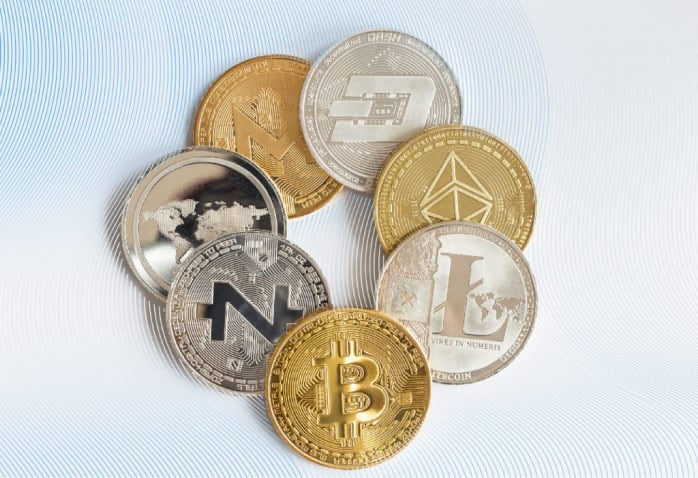
Table of Contents
ToggleWhat are Altcoins
Believe it or not, Bitcoin isn’t the only cryptocurrency… Currently there are more than 5,000 cryptocurrencies as alternatives to Bitcoin, each characterized by differences, functionality and unique purposes.
The word altcoin is an acronym derived from the words “alternative” and “coin“.
ALTCOIN are in fact the digital currencies alternative to Bitcoin, that is, cryptocurrencies other than Bitcoin. Ripple, Litecoin and Ethereum are technically “altcoin”.
The development of altcoins was fueled by the success of Bitcoin and its open source architecture. These are in fact the “fork” product of the source code whose goal is to improve some of the gaps in the Bitcoin network.
In general, altcoins work in a very similar way to bitcoin although each one was created with the aim of solving and improving some of the gaps in the Bitcoin network.
For example, bitcoin transactions take a huge and significant amount of time to process and usually have very high fees. Therefore, some altcoins are designed in such a way that they have faster processing time and lower fees.
CHARACTERISTICS OF ALTCOINS
Today there are thousands of altcoins and below we will show you the main characteristics that they have in common and that differentiate them from Bitcoin.
-
DIFFERENT MINING ALGORITHM:
There are some altcoins that use mining algorithms other than Bitcoin. For example, Nxt is an altcoin that uses PoS (Proof-of-Stake). This means that in the PoS there are no miners like in the Bitcoin network, but stackers. Stakers are people who verify transactions for rewards, just like miners. But instead of rushing to verify a block before anyone else does, they are selected one by one in turn. This system results in a drastic reduction in the use of electricity because there is no need to resort to thousands of miners who use their electricity to try to verify the same block. In the case of PoS, there is only one “staker” per block. On the other hand, bitcoin is based on Proof of Work (PoW) protocol, the most well-known and oldest consent protocol in which different computers have to solve computational calculations, validating the network and receiving rewards for their computing power.
-
BLOCKCHAIN AND AUTONOMOUS NETWORK:
Altcoins use their own blockchain, their own P2P (peer-to-peer) network. Since the Bitcoin protocol is open source, it is easy to create new coins alternative to bitcoin without the need to create a new blockchain network, since you can get the code and make changes and improvements.
-
In most cases, altcoins cannot be used for transactions or to acquire goods and/or services.
If you want to make a transaction or acquire a good or a service, you have to convert it to Bitcoin. In case bitcoins are not accepted as a means of payment in any transaction, they can be exchanged in fiat currency (such as euro, dollars or yen).
Most interesting projects of Altcoins in 2020
As we have already mentioned, most altcoins are only alternative versions of Bitcoins with small modifications.
But there are altcoins that are very different from Bitcoin because they have very different goals and because they bring value and utility to the community.
Here are the most interesting Altcoin projects that have attracted the attention of many users and institutions.
Ethereum
Ethereum is an open software platform based on blockchain technology that allows developers to create and implement decentralized applications.
Like Bitcoin, Ethereum is a distributed public blockchain network.
Aside from some significant technical differences between the two, Bitcoin and Ethereum differ substantially in purpose and capacity.
While Bitcoin is used to track ownership of digital currency (bitcoin), ethereum focuses on executing the programming code of any decentralized application.
In Ethereum, instead of mining bitcoins, miners work to earn Ether, a type of cryptographic token that powers the network.
If you want to learn more, don’t miss the article on What is Ethereum and how to mine this cryptocurrency.
Dash
Launched in 2014, the Dash cryptocurrency focuses primarily on merchant/seller payments.
Dash is based on the functionality and technology of Bitcoin, adding various management and budget capabilities, a network of master nodes and instant and private transactions.
Dash is also unique to be one of the first successful DAO, o decentralised autonomous organisations.
In fact, it was one of the first to make use of successful forms of self-financing and self-government, in which development funding comes from actual blockchain revenue and government is controlled by users who run master nodes on the network.
Dash, which is an abbreviated form of the term “digital money”, has the stated goal of making the cryptocurrency so easy to use that “even your grandmother could use it“. To this end, it is based on blockchain technology, adding new features that distinguish it from the competition.
Ripple
Ripple is a for-profit technology platform and also a cryptocurrency (XRP), developed by Ripple Labs. The company is famous for its digital payment protocol and for enabling secure, instant and free financial transactions around the world, allowing it to overcome some of the biggest obstacles facing banking institutions.
So while Ripple has as its main objective to sell its services to banks and financial institutions, Bitcoin has as its main feature to be decentralized and not to be subject to the control of institutions and governments.
Today over 100 companies around the world have adopted Ripple software to ensure fast and frictionless transactions.
Monero
Monero (XMR) was launched in 2014 as “Bitmonero”. Its goal is to promote and protect the privacy of users.
In fact, although Bitcoin offers more privacy than other financial instruments, it is not completely anonymous.
Unlike Bitcoin, Monero’s sales and transaction histories are completely private.
In addition to privacy, the comparison between Monero and Bitcoin includes other factors such as fungibility, transaction speed, transaction fees, scalability, the mining algorithm, the network effect, the offer and the price.
Advantages of the Altcoin
Bitcoin has activated the lever of change, but as a result of its creation new cryptocurrencies have emerged that evolve and present themselves as altcoin or alternative models that improve, little by little, blockchain technology.
The most positive side of the Altcoin lies in their advantages, which we summarize below:
Decentralisation: these currencies do not depend on any monetary authority that controls their issuance and/or circulation.
Utility: each altcoin is designed for a different purpose or goal, thus trying to add value to the original Bitcoin project.
Innovation: each new altcoin aims to include or provide technical details that Bitcoin did not incorporate at the beginning and seek to improve its functionality.
We can conclude by recalling that the best altcoin are those that offer an added value and differential. Today creating a cryptocurrency is easy and anyone could do it.
What is difficult and what makes an Altcoin interesting and competitive, is to offer a distinct functionality.
Not all cryptocurrencies provide value, because they are simple copies of the code.








